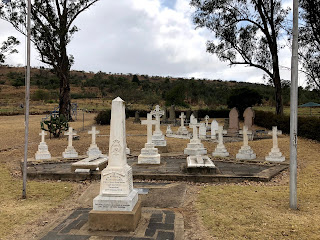Starting with Talana Hill in Dundee. Entertainingly, the museum receptionist explained that it was named after 'a small town in Scotland'. This was an early battle of the war when the Boers, under General Lucas Meyer, occupied the hill just outside Dundee. The British led by Major-General Penn attacked the hill and drove them off, albeit with heavy casualties.
This is the view of the hill from where the British troops started a firefight with the Boers.
This is the cemetery with the hill in the background.
There are a wide variety of exhibits about the area in the various parts of the museum. This was an important coal mining area. This captured Krupp gun sits outside the WW1 section.
After Dundee, I moved on to Ladysmith. I went past Elandslaagte, an interesting small scale British win, but time was pressing.
The siege of Ladysmith was one of several epic sieges during the Boer War. The town should have been abandoned because its relief forced the main field army to attack the Boers on the Tugela River. This led to huge casualties at Colenso, Spion Kop and Vaalkrans.
The town remembers the siege with signs to all the key areas and a nice walkabout guide. Sadly, largely built over and it is difficult to envisage what it looked like in 1899 under the modern town. However, there is an interesting museum full of stories about the siege and exhibits.
Outside is the famous 'Long Tom' gun the Boers used to shell the town.
And one of the British guns.
Finally, just time for one last battlefield. It had to be Spion Kop. You can drive to the top via another very bad road. Having had one puncture at Rorke's Drift, there was no scope for another!
Buller had failed to break the Boer line on the Tugela River at Colenso, so he moved upriver in an attempt to outflank them. A small British force (1700 men) used a surprise night attack to seize the summit of Spion Kop. They drove off the Boer garrison and entrenched. At daylight, they realised they had picked a poor position and the Boer counterattack, supported by artillery causing heavy casualties. Both sides withdrew, but the Boers reoccupied the hill the following day.
This is the main British monument.
The British dead were buried in their trenches, hence the unusual layout.
This is the Boer memorial.
This is taken from the forward British positions, down to what is today the Spion Kop dam. The Drakensberg mountains are in the haze behind.
And this is the view to the north and Boer held territory.
I spent the night at Pietermaritzburg. This morning I had a look around the town centre which has several monuments to the local colonial troops who died in these wars.
The museum has the most amazing collection of stuffed animals and much else. Its WW1 section has this recruitment poster. Our Advertising Standards Authority might have had something to say about this!
The long journey home now. A very interesting trip and all those figures waiting to be painted!














No comments:
Post a Comment